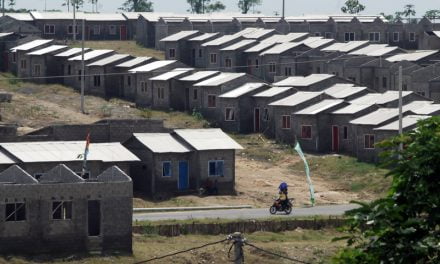This article analyzes the psychological underpinning of our recent Millennium Housing Boom in California, specifically the disproportionately influential number of speculators who bought, dragging others with them, during the final phase of the housing boom believing home prices would increase for ever more.
Between 2002 and 2005, the Millennium Housing Boom ignited and formed a misunderstood mushroom cloud over the housing market, ultimately vaporizing trillions of dollars of personal wealth across the nation. After the events of 9/11, the federal government failed to maintain the short-term interest rates they had then recently increased to correct the 1999-2000 abnormal ballooning of the real estate (and other asset) market(s). Thus, with prematurely lowered market rates, accompanied by reduced tax rates and increased spending, the federal government set the stage for the present Great Recession’s economic devastation of asset values, both real estate and stocks.
The devastated real estate prices, it seems, were largely wrought by debt-leveraged speculators. Lured by the false impression that prices would continually rise, speculators succumbed to their animal instinct of greed (and the momentum of the crowd) in lieu of a rational application of the fundamentals of the market in which they tinkered.
In 2002 and 2003, the first phase of the Millennium Housing Boom, a large and growing percentage of U.S. households perceived that it was an economically prudent time to purchase real estate. Prices had stabilized and sales volume was picking up. 72% of those homebuyers cited favorable credit conditions of low interest rates as the cause for their enthusiasm. In the middle of 2003, when prices had risen beyond consumer inflation rates and approximately two years before the peak of the boom, 85.2% of the population felt it was a good time to purchase a house, producing a bandwagon effect.
This enthusiasm coupled with an overabundance of very cheap money caused prices to naturally rise more rapidly through the second phase of the boom in 2004 and 2005. But soon, the monthly resetting of prices by brokers put a damper on most households’ enthusiasm to take up ownership of real estate as a means for providing shelter for their family. In residential rentals, occupancy rose and vacancies dropped. Instead of the market cooling as potential homeowners withdrew, a relatively small but wealthy portion of the population rushed into home purchases in a quest to profit solely from rising home prices, no occupancy intended. Their assumption was that future prices would continue to increase similar to the steep trajectory established during the first phase of the boom between 2002 and 2003.
This documented interference by speculators in the real estate market is reported in a recent study entitled “Momentum traders in the Housing Market: Survey Evidence and a Search Model,” written by Monika Piazzesi from the Federal Reserve Bank of Minneapolis. According to Ms. Piazzesi, the precise psychology which inflated the housing price bubble to such extravagant heights during the second phase of the Millennium Boom was the belief of perpetually escalating prices then held by speculators. The belief was contagious and spread among speculators with epidemic-like swiftness and voracity.
In an average year, 9.2% of U.S. households are optimistic about the future trends of home prices, meaning they believe it is a good time a buy a home since they see prices rising in the future. Thus, in tandem with the sudden increase in home prices in 2004 during the second phase of the boom cycle, a larger percentage of the population became optimistic about future home prices rising as a way to create wealth. By the middle of 2005, 20.2% of households shared this belief, becoming themselves momentum traders, commonly called speculators. They too became convinced that real estate prices could not fall below peak levels, a condition they had observed following the 2001 aborting of the recession correction then in process as engineered by the Federal Reserve, Congressional tax reduction and administrative spending increase. When this psychology was paired with unprecedented short-term property price inflation compared to low consumer inflation, the result was disastrous. Real estate prices were pushed further upwards in a self-enclosed circle: prices went up as more numbers of optimistic speculators made purchases, temporarily withdrawing property from the market. The resulting increased prices fueled the optimism of additional speculators to make even more purchases at ever greater prices.
Speculators, who accounted for 25% of real estate buyers in 2004, do not enter the real estate game with the intent of procuring a long-term source of earnings, as do investors in income property or land. They also do not intend to occupy or otherwise use the properties they purchase. Speculators, burdened with a short attention span and unconcerned with historical (equilibrium) price trends in their quest to take a profit on a flip, function more like day traders. They are injurious hit-and-run buyers who perpetually flip their purchases, all the while conscious that the financial wave they are riding will eventually crest – sea level never maintains the height of a wave. However, as real estate charlatans, speculators cannot tell precisely when the wave they’re riding will lose momentum and crash in the sand. Thus, they will take a loss when the hot market turns cold, preventing them from flipping those last purchases for profit.
Though the number of speculators increased between 2004 and 2005, they only accounted for approximately 3% of the population. The majority of households believed housing prices had climbed erratically high and opted to wait out the maelstrom as tenants, a rational decision. Rent for equivalent shelter is one-half to one-third of the cost of ownership under boom-time prices. Since most people acquired a negative impression about the real estate market (based on the fundamentals of rental value) or were content to stay put in their current homes during the second half of the boom (satisfied with home improvements), a large and increasing swath of the population was not involved in real estate activities. This gave the speculators an even larger share of the transactions closed – effectively pulling housing, new and used, temporarily off the market and making property appear scarce (much of it to return later as real estate owned [REO] resale property).
Of these transactions, the optimistic speculators pushed home prices up by agreeing to prices consistent with their inflated perception of future value. They believed any carrying costs they expended would invariably be dwarfed by future gains. In this way, the speculators, multiplying in tandem with the increase in prices and doubling up on acquisitions, were able to have a powerful effect on prices in the housing market, though they made up a comparatively small portion of the overall population.
But what could have caused this paradigm shift that turned regular households into speculators? What caused the speculators to essentially agree to collectively adopt the irrational view that this housing boom was incapable of deflating like in all previous real estate booms – 1974, 1981 and 1991?
Perhaps real estate agents, the gatekeepers of the real estate industry, are at least partially to blame for propagating this frenzy. At the very least, brokers did not exercise the knowledge they had gained by their professional experience in the early 80s and 90s to question the prevailing wisdom of speculators. Maybe they just did not understand the pervasive adverse impact of speculators, as do tract builders who abhor them.
Similar to the populous at large, a growing percentage of agents became optimistic about future home prices at the moment when prices spiked during the second phase of the boom. In 2003, 10% of agents believed home prices would increase further. In 2005, during the second phase of the boom, this amount doubled to 20% (but then so did the amount of closing and fees). Not surprisingly, the population of licensed agents spiked, as if on steroids, during the Millennium Boom. Opposed to the established long-term need of only 1,200 new licensees per month to meet the public demand for California real estate services, the number of new licensees in California swelled to 5,000 per month – staying there for nearly three years through September of 2007 – two years after the demise of flipping.
When the rumblings of the next boom become perceptive around 2016, will we, as a temporarily more enlightened civilization, be able to think back to these dark recessionary days surrounding 2010 which viciously reversed the effects of the Millennium Boom and take steps to avoid a similar fate? Or will we suffer from another epidemic of mass-amnesia, similar to the strain which infected our population during each of the previous real estate booms?
When prices begin to bubble up and speculators reclaim their place in the economic food chain, ravished and ready for feasting after their lengthy fast, can we rely on builders and brokers to exercise all their power to keep the market on a sustainable track governed by pricing fundamentals? Most importantly, will the federal government be able to prudently monitor short-term interest rates and regulate the parameters of mortgage lending – specifically, loan-to-value (LTV) ratios – to fend off economic tragedy that will otherwise re-occur?
The retention of knowledge and information is a uniquely human trait, one as hardwired into our brains as the baser (animal) instincts which propelled us into this entirely avoidable mess. History does not have to repeat itself. The real choice is in the hands of the gatekeepers and mortgage regulators.













